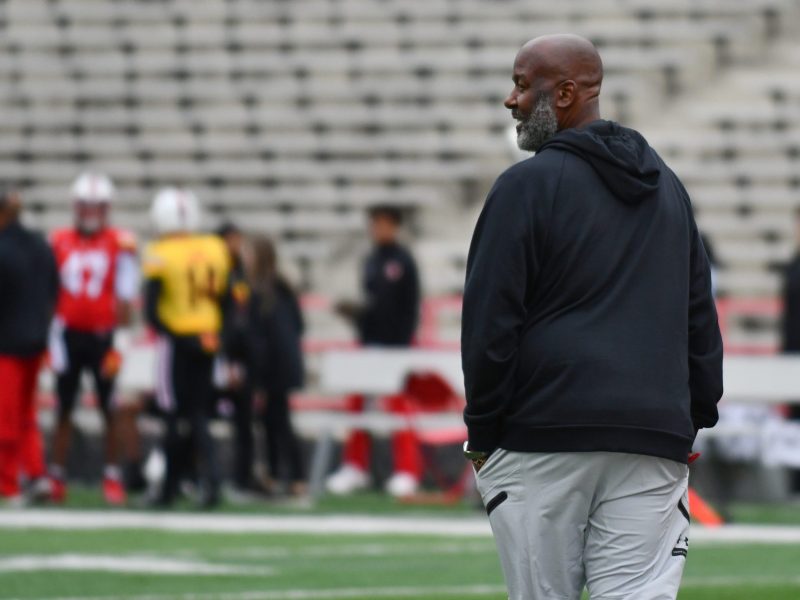April is normally a time when Maryland football would be hosting in-person recruiting visits, organizing team workouts and preparing for its annual spring game.
But what was once normal is now shifting due to the coronavirus pandemic. Recruiting has turned virtual, team workouts have turned individual and the spring game has turned to dust.
“This pandemic has altered our day-to-day lives; our sense of normalcy is gone,” University of Maryland athletic director Damon Evans said. “And some might say it’s a new normal.”
In the U.S., the coronavirus has infected more than 690,000 people and killed over 35,000. Unemployment rates have skyrocketed, education efforts have shifted online and most sports have been put on hold.
Final decisions about the college football season have yet to be made. Speculation has swirled about the impact of a potential disruption, as football teams often serve as athletic departments’ financial kingpins. Though Evans didn’t have specific numbers to indicate the extent of what that effect could be at Maryland, he said the department is preparing for the possibility of an altered season.
“Football is vitally important to our university, our athletics program, our state,” Evans said. “But that’s the same across the country. It’s vitally important for a lot of reasons, but from a financial perspective, football is very, very significant.”
Athletic programs across the U.S. are looking at different ways to limit the financial impact the pandemic may bring.
The University of Louisville and Iowa State University, among others, have announced pay cuts. The University of Wisconsin chose not to pursue waivers for its spring sports athletes that would allow them an extra year of eligibility. And the University of Cincinnati cut its men’s soccer program due to “profound challenges and widespread uncertainty.”
Maryland, meanwhile, is weighing its options.
“I don’t have a crystal ball,” Evans said. “But my job is and our job as an athletic department is to figure out how we navigate this new normal and make decisions that are going to keep the safety of and the health and the welfare of our student-athletes at the top of mind.”
About 31 percent of Maryland’s athletic revenue in fiscal year 2019 was tied to football, according to NCAA financial reports obtained by The Diamondback through public records requests. Aside from men’s basketball — which accounted for roughly 13 percent — only about 2.6 percent of revenue was tied to Maryland’s other 16 sports. The remaining revenue was not tied to specific teams.
Evans said Big Ten athletic directors have had daily conference calls to discuss how to proceed as they run through the plethora of scenarios that could play out. Some that have been discussed around the country include delaying the start of the football season, playing games without fans in attendance, shortening the regular-season slate or having no season altogether.
According to NCAA financial reports, football was the most profitable sport for 13 of the 14 Big Ten schools in the 2019 fiscal year. Rutgers did not make a profit off any sport. Maryland generated about $10.2 million in profit from football and men’s basketball combined, while its other 16 sports accounted for a nearly $23 million net loss.
“Football and men’s basketball basically pay for everything,” Evans said. “It’s the best way to put it. Football and basketball generate enough revenue for most athletic departments across the country to allow us to be able to provide for other sports.”
There are many questions surrounding the viability of non-profitable sports if the football season is altered. In 2012, then-athletic director Kevin Anderson announced that Maryland was eliminating seven teams to offset deficits in the athletic department. However, Evans said he isn’t ready to discuss that possibility.
David Berri, an economics professor at Southern Utah University, said while he anticipates some athletic departments will use the situation as a reason to cut sports that generally perform poorly financially, there’s no reason to make those types of long-term decisions.
“All of this is temporary, so even if there’s a delay [in the season], it’s just a temporary revenue decline from the loss of attendance, but then the revenue numbers all come back,” Berri said. “Making a permanent decision in response to a temporary problem seems not particularly wise.”
Berri said athletic departments dump far more money than necessary into football, and in the case that they do incur short-term deficits, there are clear areas where expenditures can be reduced — rosters with too many players, bloated salaries for assistant coaches and decked-out facilities with unneeded technology, among them.
Ticket sales, general game revenues and donations help make those luxuries possible. But the idea of playing games without fans this fall, which has been met with mixed responses from experts and athletic directors alike, would directly affect revenue sources.
On a conference call with reporters earlier this month, Ohio State athletic director Gene Smith said it wouldn’t make sense from a health standpoint, either.
“When I first heard that, I said, ‘OK, that could work,’” Smith said. “But then I figured that if we don’t have fans in the stands, that means that we’ve determined it’s not safe for them in a gathering environment, so why would it be safe for the players?”
From a financial point of view, empty stadiums — meaning the loss of revenue from ticket sales, concessions and parking while retaining TV revenue — could still be viable, Berri said.
But if the football season is canceled altogether, a more dire outcome could unfold.
Of the 276 Big Ten teams accounted for on NCAA financial reports — Northwestern is a private university and is not required to share all of its financial information — only 30 were profitable in the fiscal year 2019. Twenty-six of those 30 teams were either football or men’s basketball, with the outliers being three men’s ice hockey programs and Nebraska’s women’s volleyball team.
There are certain challenges that come with getting those other sports to turn a profit, Evans said.
“There are baseball programs that generate a profit … but they have 8,000- or 10,000-seat stadiums with suites that are selling out. Some of our venues, we have limited capacity,” Evans said. “For the most part, it’s hard for those sports to generate more money than they cost. But I never say never.”
Maryland has not had a profitable sport other than football and men’s basketball since men’s track and field in fiscal year 2013.
The uncertainty of the football season’s fate weighs heavy right now. But even as athletic directors across the country express their predictions, Evans said he knows the decision is ultimately not up to them.
“While we will have some input … that decision is going to be made by health experts and going to be made by state governments and the federal government,” Evans said. “What we need to be doing is following their lead, understanding what’s going on in our environment, and preparing different scenarios when the opportunity presents itself to return to play.”



